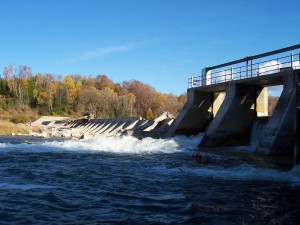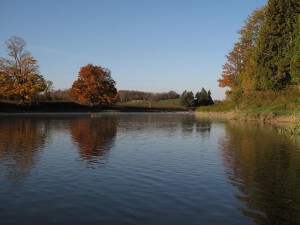The Saugeen River is the backbone of Ontario Steelheaders conservation efforts. Our work includes egg collections, stream rehabilitation, stocking fish and adult steelhead trout transfers (discontinued by MNR in 2016). Our efforts, combined with those of other local fishing clubs have made the Saugeen into one of the most popular steelhead and salmon fishing destinations in Ontario.
The Saugeen Watershed
The Saugeen drains 4,675 square kilometers, making it one of the largest watersheds in southern Ontario (the Grand River watershed is the largest at 6,800 sq. km.). The river is divided into 4 sections; the North Saugeen, the South Saugeen, the Beatty Saugeen and the Lower Main Saugeen. These 4 sections is home to numerous tributaries that provide cold water spawning areas for trout and salmon. Within the Saugeen watershed are 52 dams that are major obstacles for wild steelhead and salmon.
Dams on the Saugeen
Simply put dams act as roadblocks for migrating salmon and trout and heat the river water when flows are slowed ahead of the structure. Dissolved oxygen is crucial to support life in any aquatic system and is influenced by three key factors: water temperature, salinity, and atmospheric pressure. Oxygen gets into water by photosynthesis (during daylight plants obtain oxygen and release it into the water) or by atmospheric oxygen that is absorbed directly. It can slowly diffuse across the water’s surface from the surrounding atmosphere but rapids aerate water faster. Dams not only heat water by slowing the flow but they also reduce the amount of dissolved oxygen that is so vital to aquatic life by eliminating rapids that serve to aerate water.
Stress Dams have on Fish
Imagine landing a trout in warmer waters, in many cases, a fish otherwise properly handled and released under thermally stressful conditions may not survive. There is a considerable consensus that all three major trout species (brook, brown and rainbow) begin to experience some level of stress at around 68°F (20°C), with that stress increasing rapidly as the temperature rises further. Many believe that rainbow trout are able to survive in temperatures up to 77°F (24°C), but stop growing at 73°F (23° C). Consequently, fish must be able to reach the colder waters above dams in order to spawn successfully.
The North Saugeen
The North Saugeen River (“the North”) is a major contributer to the river system as it drains roughly 259 square kilometers of agricultural and forested land. The North meets the main Saugeen just downriver of the town of Paisley. Unfortunately, this major water contributor to the main Saugeen is predominately a warm water fishery due to the lack of protective forest cover and the 12 dams over its 52 km length. Summer river temperatures on the North are not agreeable to the preferred temperature ranges of juvenile steelhead. Nevertheless, adult fish which migrate into the North can be seen spawning in the lower stretches. At one time migrating salmon and steelhead had to navigate the Lockerby Dam , the first obstacle on the North. Thankfully, it was removed in 2015 and an unobstructed natural waterway was left in place.
Hungerford’s Crawling Water Beetle
Hungerford’s crawling water beetle was categorized as endangered on April 6, 1994, under the provisions of the U.S. Endangered Species Act. It is also protected as a Schedule 1 endangered species in Canada under the Species at Risk Act. In 1986, 42 beetles were identified at a site downstream from a dam on the North Saugeen. An unspecified number of beetles were last recorded in 2001, but surveys in 2002 and 2008 uncovered no specimens. As a result, the status of this population of Hungerford’s crawling water beetles in the North Saugeen is uncertain at present.
The South Saugeen
The South Saugeen River (the “South”) drains roughly 798 square kilometers of land which is mainly agricultural based. Ontario communities along the 97km South include: Mount Forest, Ayton, Clifford and Neustadt. This portion of the Saugeen is also home to 21 dams. This major contributing section of the system meets the main Saugeen near the town of Hanover. The “South” provides some of the most consistent angling for resident brown trout in South western Ontario, but provides little spawning water for migrating salmon and steelhead trout due to the numerous dams and access issues.
The Beatty Saugeen
The “Beatty” Saugeen is a coldwater tributary that meets the “South Saugeen” near Hanover, Ontario. This tributary of the Saugeen River is one of the most productive in terms of spawning habitat for Saugeen steelhead rainbow trout. The Beatty drains 274 square kilometres of land and stretches close to 50 kilometres in length. Invertebrate populations and forest cover on the Beatty are some of the best on the entire Saugeen watershed. This, teamed with coldwater and ample gravel beds provide steelhead with prime spawning water. The Beatty is also a release site for Ontario Steelheader adult steelhead rainbow trout fish transfers from Denny’s Dam. Like many tributaries to the Saugeen River, the Beatty has an extended spring closure, protecting steelhead rainbow trout from angling until late in the spring fishing season.
The Main Saugeen
The “Main” Saugeen is the major route of migration for salmon and steelhead rainbow trout in terms of the river proper.
The “Lower Main” is 76 kms long from Walkerton downstream to Lake Huron. From the town of Hanover, downstream to Walkerton is also considered to be the “Main Saugeen”. The lower section of river drains approximately 908 square kilometers of land and incorporates numerous tributaries, some of which are very important to the wild population of Saugeen steelhead. Major tributaries of the main Saugeen include Pearl Creek, Silver Creek, Willow Creek, the Teeswater and the Otter. The main river is home to 21 dams or which 7 are to be considered large. The lowest of these dams (Denny’s, Traux and Maple Hill) have operating fish ladders that allow migration up river for salmon and steelhead. The “Lower Main” below Denny’s Dam is know to be the most popular steelhead fishing destination on the entire river. It is here that the Ontario Steelheaders Denny’s Dam Park Campground can be found.
Steelhead
The wild fish composition of the Saugeen steelhead trout run is dependent on many variables. Many dams on the entire watershed provide roadblocks to fish migration. Warm water temperatures in the summer prove fatal to juvenile steelhead on many tributaries. Main-stem spawning by salmon and steelhead is not believed to be very productive given the dramatic changes in spring river flows, sediment loads, temperature and general river conditions. Consequently, the Ontario Steelheaders with the cooperation of the MNR and Lake Huron Fishing Club started a stocking program in 2006. Each year yearling steelhead that are successfully seeded into upper reaches of the Saugeen . These fish are easily identifiable by adipose fin clips and account for a strong portion of the annual runs of steelhead from Lake Huron. The partners involved have transformed the Saugeen into one of the most successful steelhead fisheries in the country.
For more informaion visit:
Beatty Saugeen River on Wikipedia








